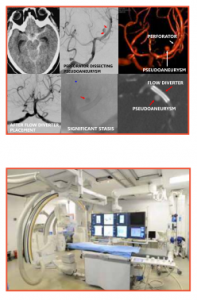Medanta Treats Aneurysm <2mm Size: Pioneers Use of Mini Flow Diverter

Medanta - Gurugram became the first hospital in India to treat aneurysm not amenable to routine surgical clipping and endovascular coiling by using mini flow diverter, a new breakthrough device used to treat very small (<2mm) distal brain aneurysms. The procedure was done successfully using minimally invasive endovascular technique without opening the skull. Until now, treating such aneurysms using surgical clipping and available endovascular devices was a challenge with relatively higher risk.

Case Study
A 51-year-old female, known case of hypertension presented in emergency on June 11, 2020 with complaint of severe headache associated with nausea and vomiting for five days.
- Her non-contrast computed tomography head showed acute subarachnoid hemorrhage.
- She was conscious with slightly dull response on examination.
- Her Glasgow Coma Scale was 15.
Digital subtraction angiography was performed which revealed very small dissecting pseudoaneurysm of posterior cerebral artery perforator on the left side, not amenable to routine endovascular coiling and surgical clipping. The patient was advised to undergo endovascular flow diverter placement procedure which would redirect the flow away from the aneurysm and subsequently initiate thrombosis of aneurysm and occlude it in follow up. Small caliber posterior cerebral artery, mini flow diverter (2.25x10mm) was successfully deployed across the perforator pseudoaneurysm. There was significant stasis achieved on delayed angiographic run. Patient was discharged in stable condition after seven days without any neurological deficit (modified Rankin Scale (mRS) score of 0).
The neuro-intervention team at the Medanta Institute of Neurosciences has immense experience in treating aneurysms using flow diverters. The team has the experience of successfully treating over 200 aneurysms.

Dr. Gaurav Goel, Director & Head - Neuro Interventional Surgery, Institute of Neurosciences - Medanta, Gurugram is a specialist in Spine Pain Neuro-Intervention and Vascular Neuro-Intervention surgeries, further explains everything you would like to know about these state of the art technology of flow diverters.
What is a Flow Diverter?
Flow diverter is a stent-like device used to treat complex aneurysms. The device is regularly used to treat intracranial aneurysms which are difficult to treat with routine endovascular coiling. Once deployed across the aneurysm neck, a flow diverter disrupts the blood flow from the parent artery into the aneurysm which then induces thrombosis within the aneurysm, resultantly decreasing the subsequent re-rupture. Over time, neointimal overgrowth covers the flow diverter, reconstructing the parent artery and eliminating the aneurysm/parent vessel interface.
Traditionally, brain aneurysms have been treated using endovascular methods such as balloon assisted and stent assisted coiling. But studies have shown their less than expected efficacy given their high rate of recanalization.
Efficacy and Safety
Flow diverter treatment has high cure rate with reasonably low complication rate. Safety and efficacy of flow diverters have been well described in literature.
Procedure
First the microcatheter is navigated across the aneurysm in the parent artery. Flow diverter is then deployed via microcatheter across the neck of the aneurysm in the parent blood vessel where the aneurysm is located. Almost immediately, blood flow to the aneurysm is reduced resulting in stasis thereby decreasing the risk of rupture. Complete occlusion of aneurysm occurs between three and six months following the procedure.
Advances in Flow Diverter
The latest innovation in this space is small size flow diverters which are now enabling treatment of aneurysmslocated in distal smaller size calibre vessels. However, they are deployed through large-size microcatheters which sometimes become difficult to navigate into the distal smaller vessels. The latest, smaller version of the flow diverter device addresses this challenge as it can be deployed with the lowest profile 0.017’ microcatheter. The advantage of the device is the easy trackability of microcatheter through the distal smaller vessels (1.5-3.5mm calibre), smooth and easy deployment, and full radiopacity with 90% resheathablity.


